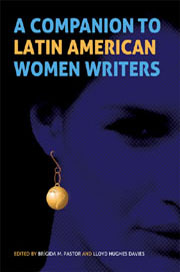Book contents
- Frontmatter
- Contents
- Introduction: The Feminine Voice in Latin American Literature
- 1 Sor Juana Inés de la Cruz (1648/51?–1695)
- 2 Gertrudis Gómez de Avellaneda (1814–1873)
- 3 Gabriela Mistral (1889–1957)
- 4 Alfonsina Storni (1892–1938)
- 5 Silvina Ocampo (1903–1993)
- 6 Clarice Lispector (1920–1977)
- 7 Rosario Castellanos (1925–1974)
- 8 Elena Poniatowska (1933– )
- 9 Alejandra Pizarnik (1936–1972)
- 10 Luisa Valenzuela (1938– )
- 11 Isabel Allende (1942– )
- 12 Rosario Ferré (1938– )
- 13 Laura Esquivel (1950– )
- 14 Laura Restrepo (1950– )
- Conclusion
- Bibliography
- Index
Introduction: The Feminine Voice in Latin American Literature
Published online by Cambridge University Press: 05 February 2013
- Frontmatter
- Contents
- Introduction: The Feminine Voice in Latin American Literature
- 1 Sor Juana Inés de la Cruz (1648/51?–1695)
- 2 Gertrudis Gómez de Avellaneda (1814–1873)
- 3 Gabriela Mistral (1889–1957)
- 4 Alfonsina Storni (1892–1938)
- 5 Silvina Ocampo (1903–1993)
- 6 Clarice Lispector (1920–1977)
- 7 Rosario Castellanos (1925–1974)
- 8 Elena Poniatowska (1933– )
- 9 Alejandra Pizarnik (1936–1972)
- 10 Luisa Valenzuela (1938– )
- 11 Isabel Allende (1942– )
- 12 Rosario Ferré (1938– )
- 13 Laura Esquivel (1950– )
- 14 Laura Restrepo (1950– )
- Conclusion
- Bibliography
- Index
Summary
Historical Overview
No se trata solamente de leer a las escritoras para (re)descubrirlas y promoverlas, sino de preguntarse de qué manera el poder se ejerce o se tolera, se sufre o se transgrede, en el espacio textual. (Araújo, 1997a: 11) [It is not only about reading women writers' texts in order to (re)discover and promote them, but about questioning to what extent power is exercised or tolerated, is suffered or transgressed, in the textual space.]
In the text of many Latin American women writers, the Word is a space for women's self-representation, a new territory to map their self-defined image, to sign with their own voice. (Medeiros-Lichem, 2002b: 211)
This Companion to Latin American Women Writers introduces the reader to an overview of the socio-historical context that has shaped the voice of these women. The diverse range of writers covered in this volume offers an exposure of feminine literary discourse, which is of great relevance to understanding the ‘matriheritage of founding discourses,’ revealing the rich textual examples of a wide range of women writers in Latin America, from those well-established to the lesser known and forgotten. The female writer has been largely absent from the literary canon with the exception of a few isolated examples2 (Díaz-Diocaretz, 1990: 104–5). It is in the recent past that women writers have gained recognition, filling a vacuum created by their exclusion, allowing the exploration of the transgressive and revolutionary import of their writings.
- Type
- Chapter
- Information
- A Companion to Latin American Women Writers , pp. 1 - 22Publisher: Boydell & BrewerPrint publication year: 2012



